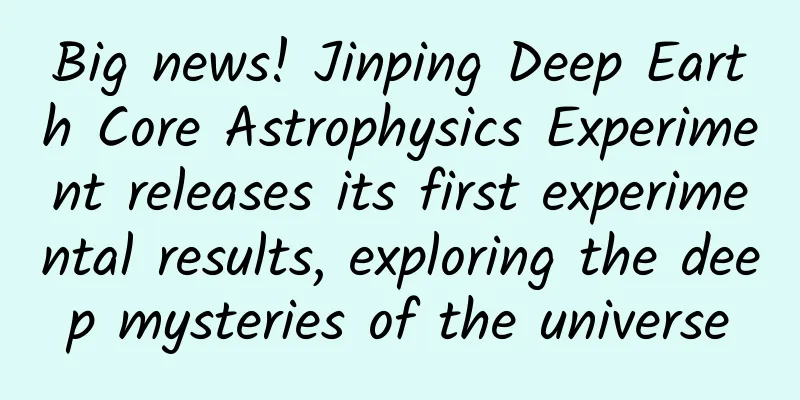Big news! Jinping Deep Earth Core Astrophysics Experiment releases its first experimental results, exploring the deep mysteries of the universe

|
"If you go to Jinping Deep Underground Laboratory, you will experience this wonderful journey that is closest to the code of celestial evolution. Passing through a tunnel of more than ten kilometers at a depth of 2,400 meters underground, next to the running instruments, accompanied by the faint flashes of amplified nuclear signals, you can listen to the beating pulse of the universe." Liu Weiping, chief scientist of the Jinping Deep Underground Nuclear Astrophysics Experiment Project and researcher at the China Institute of Atomic Energy (hereinafter referred to as IAE), who has been exploring the field of nuclear astrophysics for more than 30 years, still has bright eyes and passion when talking about the Jinping Deep Underground Experiment Project. "When I was on duty at the experimental site at one o'clock in the morning, I felt for the first time that the door of discovery was so close to me." On December 18, my country's first deep nuclear astrophysics experiment project JUNA - Jinping Deep Nuclear Astrophysics Experiment released its first batch of experimental results. Image: China Institute of Atomic Energy The measurement sensitivity and statistical accuracy of the first four key nuclear astrophysics reaction experiments released were higher than the international level of similar devices, achieving the maximum exposure, widest energy range and highest sensitivity of international nuclear astrophysics direct measurements. my country has become the third country in the world capable of conducting deep Earth nuclear astrophysics research. Image: China Institute of Atomic Energy Focus on the "holy grail" reaction of nuclear astrophysics William Fowler, winner of the 1983 Nobel Prize in Physics, once said: Most of the elements in the human body are C and O, and they are basically understood at the level of chemistry and biology. However, at the level of nuclear astrophysics, it is not understood how these C and O are produced. Therefore, this reaction is known as the "holy grail" of nuclear astrophysics, also known as the seed of the origin of life, and is very important to stellar evolution, the final fate of massive stars, the abundance of cosmic elements, and even the origin of life. The "Holy Grail" reaction is also regarded as the Mount Everest in the hearts of nuclear astrophysicists around the world. But obtaining the "holy grail" is fraught with difficulties. Directly measuring the "holy grail" reaction will yield the smallest error in the data, but the reaction is extremely weak, and an experimental site that can shield cosmic rays is a necessary condition for nuclear astrophysicists to obtain the "holy grail". Creating the most suitable environment for listening to the sounds of the universe Liu Weiping never gave up the idea of winning the "Holy Grail". In 2008, the world's deepest Jinping Hydropower Station's 17.5-kilometer-long traffic tunnel was officially opened, which immediately attracted Liu Weiping's attention. The reason why the deepest tunnel is so attractive is that the 2,400-meter-thick rock layer above the tunnel is like a thick curtain, blocking the light of cosmic rays, and the nuclear processes in stars are re-emerging underground. In 2015, China's first deep core astrophysics experiment project received major support from the National Natural Science Foundation of China. With the support of China Jinping Underground Laboratory, Tsinghua University and Yalong River Basin Hydropower Development Co., Ltd., the Institute of Atomic Energy took the lead in bringing together the Institute of Modern Physics of the Chinese Academy of Sciences, Beijing Normal University and other units to establish an experimental platform for studying nuclear astrophysics in the world's deepest and quietest experimental environment next to the Jinping Hydropower Station of Yalong River Company. Inside Jinping Underground Laboratory However, relying solely on the deep Earth's shielding of cosmic rays is far from enough. "When applying for the project, although the team had certain capabilities and experience in accelerators, detectors, high-power targets and ion sources, they were all limited to the ground and had almost no experience in deep earth." Guo Bing, deputy commander-in-chief of the Jinping Deep Earth Nuclear Astrophysics Experiment Project and director of the Institute of Nuclear Physics of the Institute of Atomic Energy, said that the Jinping experimental equipment needed to be re-developed. Liu Weiping's passion for scientific research has attracted a large number of researchers to join. The Institute of Modern Physics of the Chinese Academy of Sciences has successfully developed an advanced ECR ion source with a compact permanent magnet structure, with a beam intensity of up to 10 mA, which is 10 times that of LUNA (Italian Deep Core Astronomical Experiment Platform); at the same time, the Institute of Atomic Energy has successfully developed a short-gap accelerator tube to achieve high-efficiency transmission of high-beams, and the stability of beam energy is better than 5/10,000; the Institute of Atomic Energy and Beijing Normal University have successfully developed a BGO detector array with a detection efficiency of 70% and a resolution that reaches the best level of similar international devices; the high-power target developed by the Institute of Atomic Energy has a target power of 4kW/cm2 (kilowatts per square centimeter), which fully meets the requirements of high-beam experiments. This work is the first experimental result of Jinping Deep Core Astrophysics Experiment. The related article was published on the cover of Science Bulletin 2022, Issue 2. The first unit of the article is China Institute of Atomic Energy, and Beijing Normal University, Institute of Modern Physics, Chinese Academy of Sciences, Shenzhen University, Shandong University and other institutions are cooperative units. The first author is Professor Su Jun, and the co-corresponding authors are Researchers Li Zhihong and Liu Weiping. Innovations "snatched" from rough housing At the beginning of 2020, the Jinping Phase II laboratory had basic operating conditions, and the project team was finally allowed to carry out experimental research in the Jinping underground laboratory from the end of September 2020 to the beginning of March 2021. At this moment, Jinping Underground Laboratory is a huge unfinished house. Can we use this precious window period to carry out experiments? The team has a lot of different opinions. Those who disagree think that the time is too short. Accelerators and other equipment are precision instruments, and installation and debugging are calculated in years. In just five months, let alone conducting experiments, it is a huge challenge to achieve beam emission from the equipment. After fully listening to the opinions of the team, Liu Weiping said: "This must be done. It is worth the risk." In Liu Weiping's mind, scientific discoveries are always first and never second. In order to complete the equipment installation and commissioning in a very short time and leave enough time for scientific research experiments, the project members had to race against time and travel back and forth between Beijing and Xichang many times. From Beijing to Xichang Daliangshan, the distance is more than 2,000 kilometers. In addition to more than 3 hours of flight, there are nearly 3 hours of winding mountain roads. The project team disassembled and assembled the equipment from Beijing to the Jinping Underground Laboratory in Xichang, Sichuan. "No mistakes are allowed. Any spare parts will affect the progress of the plan, even a screw. Coupled with the impact of the new coronavirus epidemic, the task is arduous as you can imagine," said Guo Bing. The members who stayed in the laboratory often worked until two in the morning before returning to the camp, and then rushed to the scene to fight before dawn the next day. Hard work pays off. After a hundred days of hard work, they completed the installation and debugging of the equipment 5 days ahead of the planned node. On December 26, 2020, the JUNA high-intensity accelerator device fired a beam to hit the target in the A1 laboratory hall of Jinping Laboratory. A bright light pierced the darkness on the screen, which was considered to be the first ray of light to ring the "Holy Grail". The subsequent successful direct measurements of four key reactions in nuclear astrophysics achieved remarkable innovative results. For the JUNA project team, the innovative results achieved in the first batch of experiments show that the most powerful deep-flow geophysical accelerator developed by the team has become an experimental platform with significant international influence in this field. This is the first time that China has stepped into the center of the international nuclear astrophysics stage and taken a solid step towards the "holy grail" reaction. Further reading In the vast universe, stars undergo a slow process of formation, evolution, and death. The energy for these stars to emit light and heat comes from the thermonuclear fusion reactions that occur inside them. This ongoing nuclear process provides the soil for the formation of all chemical elements in nature. Nuclear astrophysics is a discipline that explores this wonderful process and its internal laws. It mainly uses nuclear physics knowledge and laws to explain the process, time, physical environment and abundance distribution of the synthesis of various chemical elements and their isotopes in the universe, as well as the impact of nuclear processes on stellar structure and evolution. Picture丨TuChong Creative Nuclear astrophysics is one of the frontier areas of basic scientific research. my country's long-term development plan for physics lists nuclear astrophysics as an important development area, and the measurement of astro-nuclear reactions based on deep underground laboratories can provide the most basic and accurate experimental data. The China Jinping Underground Laboratory is located in Jinping Mountain, Liangshan Prefecture, Sichuan Province. It is currently the deepest underground laboratory in the world, with vertical rock coverage of 2,400 meters. In order to better carry out direct measurement research on key reactions in nuclear astrophysics, the China Institute of Atomic Energy took the lead in jointly working with the Institute of Modern Physics of the Chinese Academy of Sciences, Beijing Normal University and other domestic and foreign superior forces to complete the installation and operation of the deep underground accelerator in the China Jinping Underground Laboratory. On December 26, 2020, the high-current accelerator successfully emitted a beam, becoming the world's strongest deep-current accelerator, and was praised by General Secretary Xi Jinping as one of the achievements of "making new leaps in the field of strategic high technology." Inside Jinping Underground Laboratory Achievement 1: The 25Mg(p,γ)26Al reaction achieved the highest international precision measurement In the 1980s, astronomical observations found a large amount of 26Al in the interstellar medium of the Milky Way, with a content of about 3 times the mass of the sun. However, the life span of 26Al is less than one million years, and the 26Al produced in the early stage has disappeared. The source of so much 26Al in the Milky Way has become a hot topic in astrophysics. The 25Mg(p,γ)26Al reaction is the key reaction for producing 26Al in stars. As the key reaction for producing 26Al, 25Mg(p,γ)26Al is of great significance for explaining the origin of 26Al. The JUNA experiment achieved the highest international precision measurement of the 92keV resonance that plays a decisive role in this reaction, and the experimental results were published as the cover result of the top international physics journal "Science Bulletin". Achievement 2: 19F(p,αγ)16O obtains the most accurate reaction rate data in the world 19F(p,αγ)16O is a key issue in the evolution of AGB stars. Astronomical observations have found that AGB stars have an overabundance of fluorine, which is tens or even hundreds of times more abundant than in the solar system. The standard stellar model cannot explain this phenomenon. Accurate measurements of the 19F(p,αγ)16O reaction will help solve the problem of fluorine overabundance. The JUNA experiment has for the first time expanded the measurement range to the astrophysical energy region, and obtained the most accurate reaction rate data in the world. The experimental research results were published in the top international physics journal Physical Review Letters and were recommended by the editor. Achievement 3: The 13C(α,n)16O reaction completely covers the astrophysical i-process energy region for the first time The 13C(α,n)16O reaction is an important neutron source reaction. How elements heavier than iron are synthesized has always been the most important question in nuclear astrophysics. It is now known that about half of the elements heavier than iron are formed through the slow neutron capture process (s process). The raw neutrons in this process are provided by the 13C(α,n)16O reaction. The precise measurement of this reaction is of great significance for understanding the synthesis of heavy elements. The energy range measured by the JUNA experiment completely covers the astrophysical i-process energy region for the first time, clarifying the three-fold disagreement in the past direct measurement data. Achievement 4: 12C(α, γ)16O reaction measurement achieves the highest international sensitivity The 12C(α, γ)16O reaction is the most important reaction in nuclear astrophysics experiments and is known as the "holy grail" of nuclear astrophysics. On the one hand, this is due to the importance of the reaction: it directly determines the ratio of carbon and oxygen, the two most important elements that make up life, in the universe; it has an important impact on the abundance of almost all nuclides up to uranium; and it determines the ultimate fate of the evolution of massive stars. On the other hand, the reaction mechanism is complex, the cross section is extremely low, and experimental measurement is very difficult. The experimental measurement of the project reached the lowest energy in the world, close to the astrophysical energy region, and achieved the highest sensitivity of reaction measurement, taking an important step towards winning the "holy grail". my country's Jinping Deep Earth Laboratory has unique shielding conditions, with rock thickness 1,000 meters thicker than Italy, and the intensity of cosmic rays is two orders of magnitude smaller. With the support of the National Natural Science Foundation of my country, China National Nuclear Corporation and the Chinese Academy of Sciences, China's deep earth nuclear astrophysics team has successfully developed an accelerator device with a flux of up to 10 mA. A BGO gamma detector array with a geometric efficiency of more than 90% has also been built, which achieves the highest energy resolution in the world after cooling. Compared with deep earth laboratories in the world, the Jinping nuclear astrophysics experimental device has the following advantages: the laboratory has the lowest background level, the deep earth accelerator has the highest beam intensity, and the BGO gamma detector array has good energy resolution. With this advantage, the research team began measuring the 92 keV resonant capture reaction on January 1, 2021. After 15 days of hard work day and night, they obtained the world's most accurate measurement results. As shown in the figure, the experimentally obtained resonance intensity error is 8%, and the ground state distribution factor error is 6%, both of which are the world's most accurate experimental results. Comparison of Jinping's experimental results with existing data Image source: Science Bulletin The results show that at the temperature of 0.1GK, which is of interest to AGB stars, the experimental reaction rate is 2.4 times greater than the international evaluation result, which means that AGB stars can produce more 26Al. This high-precision reaction rate data will provide a good constraint for the convection model of AGB stars and provide important data support for explaining the abnormal abundance distribution of globular clusters. Comprehensive sources: Science and Technology Daily, China Science Magazine, China National Nuclear Corporation, Modern Physics Knowledge, etc. |
Recommend
Coral fleece and milk fleece, I finally know how to choose!
(Pictures from the Internet) In fact, it is not j...
Swift is open source, what are the benefits?
Swift is open source, great news that makes you c...
Do user needs really need to be met?
"Users say they want this feature, why haven...
The most romantic thing I can think of is looking up at the stars with you...
"The stars are twinkling, the moon is round....
Did you eat glowing shrimp meat because of nuclear wastewater? Here comes the February science rumor list →
1. If you are nearsighted when you are young, can...
Pick-up master Chris Ke Lisike teacher · High-level framework to create red pill members red pill awakening
Pick-up master Chris Ke Lisike teacher · high-lev...
How do websites make money from traffic? How to make money through website traffic?
If you have traffic on your website, there are ma...
Operational promotion: 4 steps to detonate your growth!
What I want to share with you today is that user ...
Tutorial on how to attract traffic with short videos on Tik Tok!
1. Register a short video platform account : If y...
How to tap into high-value customers through different channels?
Before their first contact with a salesperson, co...
How to conceive a planning proposal in a clear and organized manner?
I have heard many of my friends and colleagues ta...
The human gene pool has a "new member"! Chongqing researchers discovered a new allele for the first time and were named by the World Health Organization
On July 7, a reporter from Chongqing Daily learne...
Often forgetful? More and more adults are diagnosed with this disease! You may be...
This Olympic Games It's exciting to watch Eve...
It’s so cold in winter, will eating fruit hurt your stomach?
Image from: pexels.com The weather is getting col...









![[Scholars from the Saiwai] 20220521 Dragon Control Secrets (II): The Rules and Methods of Changing Dragons + Next Week's Prediction Midday Review](/upload/images/67cbffe7561b4.webp)